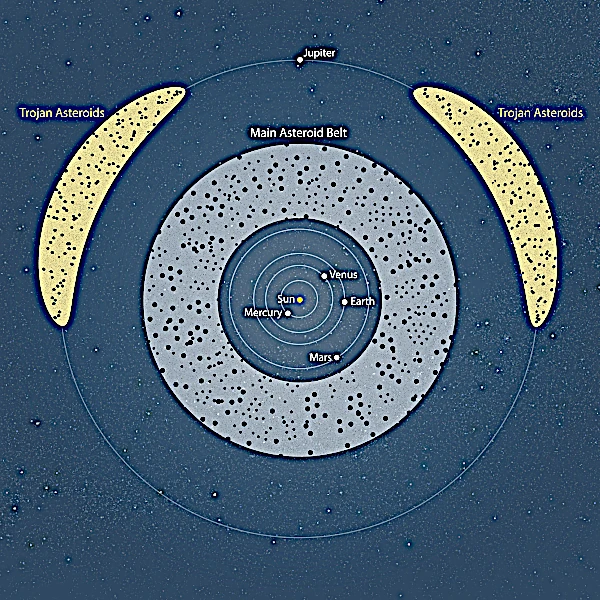
The main asteroid belt is a region of the solar system located between the orbits of Mars and Jupiter, containing the highest concentration of rocky celestial bodies called asteroids. This fascinating area provides valuable insights into the conditions that prevailed during the formation of the solar system about 4.6 billion years ago.
The main belt formed from the protoplanetary disk surrounding the young Sun. The gravitational influence of Jupiter prevented the accretion of materials into a planet, leaving fragments of various sizes instead.
The first asteroid was discovered on January 1, 1801, when Giuseppe Piazzi (1746-1826) observed Ceres from the Palermo Observatory. Soon after, other objects such as Pallas, Juno, and Vesta were identified in the early 19th century, gradually establishing the existence of a region rich in small bodies between Mars and Jupiter.
During the 20th century, the use of astronomical photography and early computers significantly accelerated the census of asteroids. Today, thanks to automated surveys such as LINEAR, Pan-STARRS, and the future LSST (Legacy Survey of Space and Time), hundreds of thousands of main belt asteroids have been cataloged.
Direct exploration by space probes began with the Galileo mission (NASA, launched in 1989), which performed the first close flybys: Gaspra in 1991 and Ida in 1993. These observations confirmed the morphological diversity and fractured nature of small bodies.
More recently, the Dawn mission (NASA, 2007–2018) studied Vesta (2011–2012) and then Ceres (2015–2018) in extended orbit, revealing complex geological structures, salt deposits, and evidence of cryovolcanism.
Main belt asteroids exhibit an extremely wide size distribution, ranging from less than one kilometer to nearly 1,000 km in diameter. The largest bodies—Ceres (~940 km), Vesta (~525 km), Pallas (~512 km), and Hygiea (~430 km)—account for more than 50% of the belt's total mass. However, most objects are fragments only a few kilometers in size, produced by an intense collisional history.
The number of asteroids with a diameter greater than \(D\), denoted \(N(>D)\), approximately follows a power law: \( N(>D) \propto D^{-q} \) where the exponent \(q\) varies depending on the size range considered. For small bodies (\(D < 10 \, km\)), \(q \approx 2.5{-}3\), indicating a population rich in small fragments. For larger bodies (\(D > 100 \, km\)), the slope is lower, reflecting the rarity of these primitive objects that have not been completely fragmented.
These estimates illustrate the hierarchy: the smaller the size, the more rapidly the population grows. This abundance of small objects continuously fuels the flux of meteoroids observed from Earth. Not to be confused with meteorites, which are fragments of celestial bodies that pass through the atmosphere and reach the Earth's crust.
| Category | Diameter (D) | Estimated Number | Mass Proportion | Examples | Characteristics / Composition |
|---|---|---|---|---|---|
| Giant bodies | > 400 km | 4 | > 50% | Ceres, Vesta, Pallas, Hygiea | Internally differentiated structure: metallic core, silicate mantle, crust |
| Large asteroids | 100–400 km | ~200 | ~30% | Interamnia (~330 km), Euphrosyne (~260 km) | Survivors of initial accretion, dominant mass in the belt |
| Medium bodies | 50–100 km | ~2,000 | ~10% | Hygiea (examples) | Significant fragments but less massive than large bodies |
| Small bodies | 10–50 km | ~20,000 | ~5% | Eros, Sylvia | Mixture of silicates (S), carbon (C), metals (M) |
| Very small bodies | 1–10 km | 1–2 million | < 1% | Itokawa (~0.33 km), Bennu (~0.49 km) | Ordinary chondrites, porous regolith, collision fragments |
| Microscopic bodies | 10 m–1 km | ~500 billion | < 0.1% | - | Very small fragments, fuel the meteoroid flux |
Trojan asteroids are small bodies that share the orbit of a more massive planet or asteroid, remaining localized around gravitational equilibrium points called Lagrange points. In the Solar System, the most famous are Jupiter's Trojans, but there are also Trojans associated with Mars and some large main belt asteroids.
Some of the large asteroids in the main belt have their own "Trojans": small co-orbital satellites that remain stabilized in the gravitationally stable zones around the L4 and L5 points, located ±60° ahead of or behind the main asteroid in its orbit. For example, Hektor (a Trojan asteroid of Jupiter) has a small companion, but similar configurations exist on a smaller scale in the main belt.
These bodies likely formed from the same material as their parent asteroid or were captured through gravitational interactions during the history of the main belt. Numerical simulations show that Trojans can remain stable for billions of years, provided the main asteroid's orbit is relatively circular and not excessively perturbed by Jupiter.
Current and upcoming missions, such as Lucy (NASA, launched in 2021) and Hera (ESA, planned for 2026), will refine our understanding of the evolutionary processes of small bodies and their role in the dynamic history of the Solar System.
Future missions envision asteroid mining for their precious metals and water resources, the latter of which can be converted into propellant for long-distance space travel.